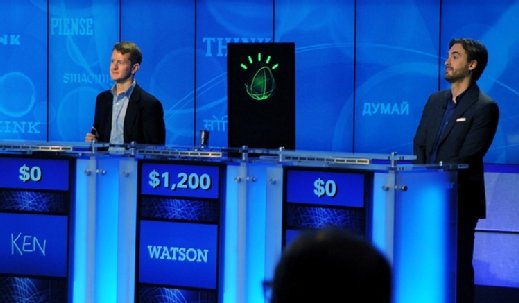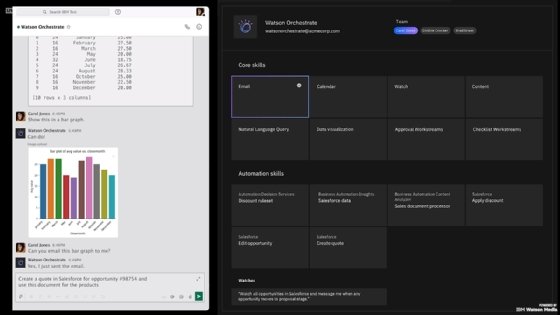IBM Watson supercomputer
What is the IBM Watson supercomputer?
Watson was a supercomputer designed and developed by IBM. This advanced computer combined artificial intelligence (AI), automation and sophisticated analytics capabilities to deliver optimal performance as a "question answering" machine. The supercomputer was named for Thomas J. Watson, former chairman and CEO who renamed Computing-Tabulating-Recording Company, founded in 1911, to International Business Machines in 1924.
History of IBM Watson
In a fall 2010 article published in AI Magazine, IBM researchers reported on their three-year journey to build a computer system that could compete with humans in answering questions correctly in real time on the TV quiz show Jeopardy!. This project led to the design of IBM's DeepQA architecture and software and the Watson supercomputer.
By late 2010, Watson's question-answering technology was advanced enough to enable it to win about 70% of games against former human Jeopardy! champions. In 2011, its capabilities were put to the test in a real game on Jeopardy!. Watson challenged two top-ranked players -- Jeopardy! superstars Ken Jennings and Brad Rutter -- and famously beat them. The Watson avatar sat between the two contestants, as a human competitor would, while its considerable bulk sat on a different floor of the building. Like the human contestants, Watson didn't have internet access. However, unlike them, it had the power of AI at its disposal. Watson's famous victory against two human Jeopardy! champions helped showcase the power of AI and its potential for solving business challenges.
Following this accomplishment, IBM researchers claimed that Watson's DeepQA architecture was both effective and extensible and, therefore, could be used to combine, deploy, evaluate and advance numerous algorithmic techniques in the field of question answering. A day after the Jeopardy! victory, IBM also advertised that it was exploring ways to apply Watson's capabilities for real-world applications in healthcare, law, academia, finance, transportation, retail and other sectors.

How Watson worked
Watson's question-answering capabilities were honed over several years. The more information it was fed, the more its ability to respond correctly improved. A lot of the information came from commercial sources, like World Book Encyclopedia, and online sources, like Wikipedia and Project Gutenberg. By 2011, it could hold information equivalent to almost 1 million books and compile information from numerous sources to answer a variety of questions.
Watson's information-holding capability partly accounts for its ability to answer complex questions that included numerous subtleties and wordplay -- questions like the ones that frequently appeared on Jeopardy!. In contrast, older question-answering software and search engines could only analyze simple questions and provide straightforward answers, making Watson a true innovation in the field of AI.
When Watson was asked a question, more than 100 algorithms analyzed it and put forth many different plausible answers at the same time. A different set of algorithms ranked the answers and looked for evidence to support or refute each answer. Based on the supporting evidence, each answer was given an individual score. The highest-ranking answer would become the final answer that Watson would display in response to the asked question. Watson completed all these steps in just about three seconds, about the same time most humans would take to listen to a question, analyze it and then propose an answer.
Watson technical details
Since Watson was a supercomputer, it ran on a cluster of dozens of IBM Power 750 servers -- 90 to be specific. Its architecture consisted of 10 racks holding these servers and 2,880 processor cores. Watson came installed with IBM's DeepQA software, which incorporated natural language processing (NLP) and machine learning and was specifically designed for information retrieval purposes.
Some of the other components of IBM Watson were the following:
- 15 terabytes of RAM.
- 500 gigabytes of pre-processed information.
- SUSE Enterprise Linux Server 11 operating system.
- Apache Unstructured Information Management Architecture frameworks, infrastructure and other elements for the analysis of unstructured data.
- Apache's Hadoop Java-based programming framework for the processing of large data sets in distributed computing environments.
IBM Watson: A decade after Jeopardy!
Watson was the brainchild of IBM Research, one of the world's largest research organizations that has 12 labs globally. In 2011, IBM Research was headed by John Kelly. Kelly, often called the "Father of Watson," was one of the biggest supporters and proponents of Watson. At the time of Watson's Jeopardy! victory, Kelly said that Watson would eventually evolve into a commercial product. This product was expected to provide advanced, state-of-the-art information that could potentially improve the intelligence of decision-makers in many industries.
Over the next decade, Watson became synonymous with AI. However, numerous challenges and IBM's missteps prevented Watson from reaching its expected heights. Today, Watson is not a single computer, but rather a suite of products that enable organizations to infuse AI and automation into business workflows. The latest product in the Watson suite is called Watsonx, an enterprise-ready AI and data platform that organizations can use to train and deploy machine learning models for a range of applications and use cases.
IBM Watson suite of enterprise products
The Watson suite includes numerous products, each with its own unique selling proposition and purpose. However, all products are based on AI technology and aimed at helping organizations incorporate AI into core business workflows, including workflows for human resources, customer service, software development, legal and knowledge management.
These products constitute the Watson suite:
- Watsonx Orchestrate. Watsonx Orchestrate provides open application programming interfaces and robotic process automation integrations that help to streamline processes and automate repetitive or complex tasks. The platform also facilitates communication to improve collaboration between team members. It uses NLP and pre-built skills to automatically execute user requests in the right order. Both existing and new automations can be imported into Orchestrate based on business needs.
- Watsonx Assistant. Watsonx Assistant is a conversational AI platform designed to deliver intelligent customer care across multiple channels. Powered by large language models (LLMs), Assistant can provide fast, accurate answers to prospects, customers and employees across a variety of applications, devices or channels.
An organization can use Assistant to build AI-powered voice agents and chatbots to deliver automated self-service omnichannel support. Assistant can seamlessly integrate with existing business tools, including customer relationship management systems, search tools and contact center platforms, so organizations can bring conversational AI into business processes without having to migrate the tech stack. - Watsonx Code Assistant. Watsonx Code Assistant provides AI-generated recommendations so software developers can quickly and easily write software code. It uses tailor-made foundation models that can be customized with enterprise standards to accelerate time to value for both developers and the organization. The models are pre-trained and based on specific programming languages to ensure accurate code generation for targeted use cases.
![IBM Watsonx Orchestrate screenshot]()
IBM's new Watsonx Orchestrate system uses AI to pull in data from apps and user history to complete tasks. - IBM Watson Discovery. IBM Watson Discovery is an AI-powered intelligent platform for document understanding and content analysis. It uses NLP and natural language understanding to automate information discovery and insights generation. Powered by custom NLP models and LLMs, Watson Discovery enables teams to parse complicated business documents and analyze text data to understand critical components inside the documents and get the information they need in a timely manner.
- Watson Studio. Watson Studio provides a set of code-free tools to prepare and analyze data and to develop sophisticated machine learning models. Its AutoAI feature automates data preparation and model development so nonprogrammers can build models without coding. Studio also simplifies the deployment of prescriptive models and provides dashboards to investigate solutions for multiple scenarios.
Learn all about 15 of the best LLMs, and explore seven generative AI challenges that businesses should consider. See how to start learning about NLP, and check out the key differences among AI vs. machine learning vs. deep learning.







